During his 14 year Major-League career Shawn Green looked as though he could have been destined to become the next Ted Williams. He was a left-handed hitter, tall, slender, with features closely resembling those of Williams, including remarkable strength, quickness of bat, and fluidity of movement that Ted exhibited. 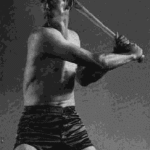 He may even have had his keen eyesight.
He may even have had his keen eyesight.
If Shawn had ever thought of himself as a possible replication of the “Immortal” Williams, it was never evident in his own style of bats-man-ship – his approach to the ball. 
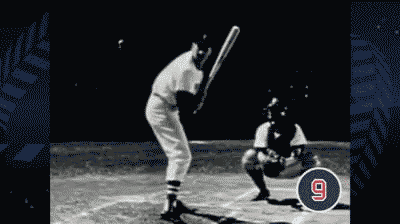
And that stance and approach to the ball are what prevented him from becoming the “next Ted Williams”!
Although Shawn displayed every recognizably natural, physical attribute of Mr. Williams, he did not have the willingness (good sense) to attempt to duplicate the scientifically sound mechanics that Ted practiced with profound consistency, beginning with his stance.
Shawn Green was an outstanding ball-player both offensively and defensively. He even hit 4 Home Runs in one game. But the ultimate success that he would have achieved could only have come had he abandoned his “High-Opened” stance. The irony was that he accredited the minimum success he achieved to his “open-stance.” 
As I have elaborated on in previous essays, the 3 most detrimental habits or propensities that a batter can display while trying to hit a baseball are:
1. Standing Tall – This creates greater strike-zone for the pitcher to negotiate, a high center of gravity to diminish the batter’s speed with which to negotiate the subtleties of the pitched ball, and diminished visual acuity for following the ball that is transcending countless horizontal planes into the lower portion of the strike-one.
2. Hands and Bat High – Even in a good crouch position the bat up-high establishes a “higher” center of gravity as well as presents the batter with a nebulous sense of how to approach the pitched ball (e.g. Matt Kemp)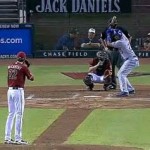 . A pitch high and out of the strike zone sometimes looks too enticing to the hands and bat that are at its level. A middle level pitch is easy swing under. And a low pitch (the best prospect to hit well) can sometimes effect a “horse-shoe” swing.
. A pitch high and out of the strike zone sometimes looks too enticing to the hands and bat that are at its level. A middle level pitch is easy swing under. And a low pitch (the best prospect to hit well) can sometimes effect a “horse-shoe” swing.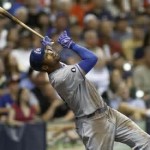
3. The “Stride” – Any stride at all is a deterrent to efficient hitting because the whole body moves. 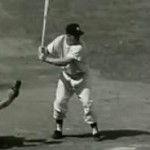
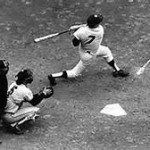 And with the body moves the head which houses visual mechanism for seeing the ball, and all its subtle movements. But of the 3 types of deliberate strides, that one from an “opened stance” is the most egregious of all because the movement of head and eyes is toward home plate.
And with the body moves the head which houses visual mechanism for seeing the ball, and all its subtle movements. But of the 3 types of deliberate strides, that one from an “opened stance” is the most egregious of all because the movement of head and eyes is toward home plate.
Most batters, who adopt the open-stance, act with the false assumption that they see the ball more clearly because, as they begin their movement toward the plate, their faces and eyes are totally “frontal” to the pitchers’ delivery. Supposedly, if one eye is less dominant from the other, together and parallel they will see more clearly. Whether that is true, or not, as the body turns as to approach the plate and the ball, the eyes are “closed” again, with one in front of the other. So the strategy thus serves no practical purpose.
Batters in an open-stance can be successful for a while, because more pitchers can be under the false-assumption that such a batter is looking for the inside pitch, to pull. So their instincts tell them to keep the ball away.
This type of batter’s momentum is generally going with the ball away, and hits it well. He will guess when a pitcher is going to come inside, and be ready. But after a while the good pitchers will understand this batter’s intentions and figure out how handle him properly.
If the pitcher starts such a batter with inside “heat,” then works him slightly outside the strike-zone, then back to inside strikes, the batter will usually not be able to adjust to the variance effectively.
 As you might be able to surmise, this typical picture of Shawn Green at bat presents multiple “margins for error.” You can notice his large strike-zone in which to try to discern the greatest variance of pitches from top to bottom within the strike-one. Since he stood so close to the plate, he covered the width of it very well. But, when gliding inward, pitchers started finding him extremely vulnerable to inside “heat.” He was always quick enough to get out in front of the fast-ball, but almost always pulled it foul (if he didn’t get “jammed”). Then, “soft-stuff” away caught him off-balance.
As you might be able to surmise, this typical picture of Shawn Green at bat presents multiple “margins for error.” You can notice his large strike-zone in which to try to discern the greatest variance of pitches from top to bottom within the strike-one. Since he stood so close to the plate, he covered the width of it very well. But, when gliding inward, pitchers started finding him extremely vulnerable to inside “heat.” He was always quick enough to get out in front of the fast-ball, but almost always pulled it foul (if he didn’t get “jammed”). Then, “soft-stuff” away caught him off-balance.
Most batters who stride don’t realize to what extent even the slightest movement of the head and eyes has on the visual acuity for seeing most clearly a moving object. Plus, when the front foot is in the air, the batter has trouble putting it down at the right time (especially on off-speed pitches).
Even catching a moving object while the body is in motion is difficult. Trained outfielders were not always adept at chasing and catching fly-balls. And catching a low throw while standing erect presents the same difficulty as hitting a ball from a high-stance.
Imagine yourself with only a catcher’s mitt in hand, and standing erect behind home-plate while attempting to catch an Arnoldus Chapman knee-high fastball(105 MPH). Then imagine yourself Moving while trying to catch it.
A catcher in a low, stable, and still position has difficulty catching it. So, a batter in a high stance, and moving toward a pitched ball is always a detriment to his own best intentions. Exacerbated even further is the “high-opened-stance” and stride toward the plate.
Shawn Green, like all otherwise outstanding batters, did not (and do not)realize that Baseball is more than “a game of inches,” as the traditional cliche implies, but rather “a game of milli-microns,” where the light of understanding is transcended in Science. The scientific logic that his approach was lacking legitimacy went beyond Shawn’s superficial testimony of sense that convinced him that his technique “felt good.” To his credit, Shawn was never a “bad-hitter.” He simply never attained the greatness that he could have experienced – the “next Ted Williams!
Ted Williams was probably the epitome of the “Ideal-Hitter.” He approached “hitting” from a scientific standpoint. 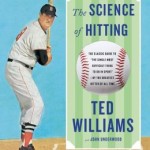 Therefore, it wasn’t so much how he felt at the plate. It was how well he was following his understood principle that determined the outcome of his stroke, in most of his batting situations.
Therefore, it wasn’t so much how he felt at the plate. It was how well he was following his understood principle that determined the outcome of his stroke, in most of his batting situations.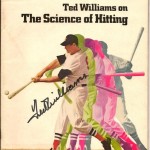
To watch Ted at the plate one would become aware of the fact that the act of hitting a baseball efficiently is both an “Art” and a “Science.” Those who demonstrate a high degree of talent in any of the various art forms could easily be described as “artists.”
There is adequate evidence to indicate that many or most good artists (of which athletes like Shawn Green are included) have a “natural” propensity toward the artisan-ship in which they are engaged. But their optimal level of proficiency is most often derived from the degree to which they accumulate enhanced understanding by means of scientific examination of all aspects of their chosen profession. Therefore, hitting a baseball most effectively would have to be construed as both an Art and a Science. And that is why it would be easy to remember Ted’s “Masterful Bats-man-ship” for its scientific artistry in hitting a baseball.
Coming Soon: Is Chris Davis the Next Barry Bonds (without Steroids)? Part 3 of 3